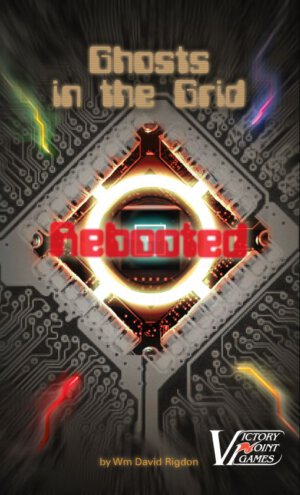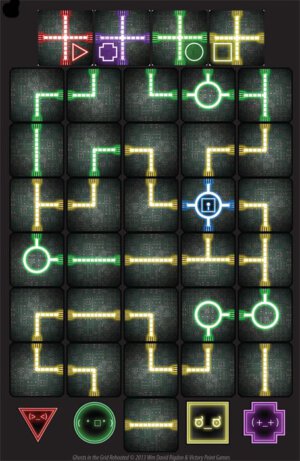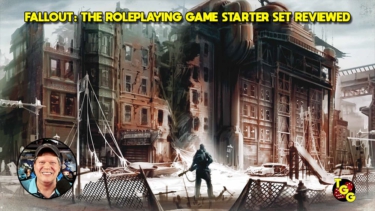
Publisher: Victory Point Games
Game Design: William David Rigdon
Graphics: Clark Miller
Year: 2013
Players: 2-4
Ages: 13+
Playing Time: 45 minutes
Retail Price: $23.95 for the boxed edition; $20.95 for the polybag edition
Category: Abstract Cyberpunk Card Game
Contents
- 16-page full color rules book
- 35 tiles
- 4 player pieces
- 4 player mats
- 75 cards
- 4 cheat sheets
- 2 baggies (presumably to store your tiles and player pieces)
- 9 1/4″ x 5 7/8″ game box
From Victory Point Games: “Ghosts in the Grid Rebooted is a 2 to 4 player card game where each is a computer hacker (represented by their Ghost Agent marker) out to retrieve the Data. By creating the gameboard (‘Grid’) with all unique tiles, the Grid changes each time you play! Players play cards to improve their own Ghost powers, infect their opponents with Virus cards, and fix their own computer’s infections with Fix cards. The goal is to move your Ghost Agent through the Grid to gather the Data and escape with a clean (uninfected) copy of it. If you have too many Virus cards on your Ghost Command Row at once, you will be Assimilated and will have to start over again! If all players are Assimilated simultaneously, the Grid wins and the Data is safe. Do you think you have what it takes? Prepare yourself with Ghosts in the Grid Rebooted!”
So do you have what it takes to hack your way to victory? Let’s see!

This is my second VPG game and have to say I cannot get over how sturdy the counters are. These little guys will not bend or fold unless you put them in a vise and take a pair of pliers to them. I really like that. The cards are sturdy but they will bend. I’d say they’re of average density. Not too light and not too thick. The remaining components appear to be made from the same light cardboard/heavy paper stock. The art on all the components follows the box art: full color and computer-like.
For the game setup, imagine a 5 inch by 5 inch playing area which contains 25 inch squares. This will be called the Grid. The Central Node tile is placed in the middle.
- One Entry tile is placed in each corner. Each player then puts their Ghost Agent marker on the corresponding Entry tile.
- The Inner (green pipeline) and Outer (yellow pipeline) tiles are turned face down and shuffled.
- You randomly select eight Inner tiles and place them around the Central Node tile. Then you randomly select 12 Outer tiles and place those in the remaining spaces of the play area. The remaining Inner and Outer tiles are set aside and designated as the Grid Pool. The Inner and Outer grid tiles are now turned over. They all have to be turned over in the same manner: either horizontally or vertically.
- Each player takes a Ghost Command Row and places it at a 45 degree angle to the Grid.
- Look for the two Data cards: Each will be titled Local Data on one side and Network Data on the other. Each card is placed adjacent to the Grid; one on each side.
- Shuffle the remaining cards and deal 5 to each player. The deck is also placed next to the Grid.
- Determine who goes first. It’s up to you how you determine this. Some examples are the oldest player or the owner of the game. I might suggest a die roll, a round of rock-paper-scissors, or an all-out cage match…uh, ok, scratch the last suggestion. Just making sure you’re paying attention…

- Play a card or cards. I’ll explain the types of cards you might have in your hand. Ghost cards can only be used when they’re played on a Ghost Command Row and not covered with a Virus card. Ghost card commands are Broadcast, Hack, Operate, Overclock, Rotate, Search, Sort, and Switch. Virus cards come in seven varieties: Bad Sector, Corruption, Crash, Encrypt, Hijack, Lag, and Spyware. Fix cards come in six varieties: Anti Virus, Backup, Decrypt, Defragment, Delete, and Restore. Data Eject cards require all players to “eject” any Data cards they have so the Data cards become un-owned and loose.
- Determine if you’ve become assimilated. If all your Command Row spaces are infected, you can’t reboot, or you can’t continue your turn then you’ve become assimilated and are now a part of the Grid. At this point, you remove your Ghost Agent from the Grid. Once you’re assimilated you can unassimilated by using Fix cards to remove at least one Virus. Then you can return your Ghost Agent on an empty Grid tile and continue play.
- Reboot yourself if you so desire. If you play all your desired cards and are not assimilated, you can choose to forfeit the rest of your turn and reboot. If you do this, you discard all your cards, turn loose any Data card you have, put your Ghost Agent on any Entry tile, and draw five new cards.
- If you didn’t reboot, you can use any active Ghost cards or quarantine a Virus card on your Command Row.
- At this point, you can play a Defragment card and forfeit the remainder of this phase or you can move your Ghost Agent. If you move, you must move through “orthogonally connected Grid tiles up to the number of spaces on your Command Row which are not infected by Virus cards.” If you move adjacent to the Central Node tile and a Data card is in the middle of the table showing its “Local” side, you can add it to an empty space on your Command Row or overwrite an active Ghost card unless it’s on the space where only your pre-installed Rotate card. You immediately win the game if you have an uninfected Data card on your Command Row and you have your Ghost Agent marker on your Entry grid tile.
- Discard cards up to the number of spaces in your Command Row which don’t show an active Ghost card. Then draw your hand back up to five cards.
Overall, I think Ghosts in the Grid Rebooted is a game which will have a very narrow audience. If your employment, degree, or interests lie in the programming arena, then you may enjoy this one. I suppose if you’re a real life hacker or even a wannabe hacker, then this title is for you as well. For the rest of us, this game may be a bit too involved and abstract for a session of casual gaming.
- The Truth is Out Where?: A Review of ‘Conspiracy X 2.0’ - Jun 13, 2013
- Dueling Memes: A Review of ‘Aliens vs. Zombies’ - Jun 1, 2013
- Give It a Shot: A Sneak Peek at Boozle - May 22, 2013
TGG SCORE - 6
6
Overall, I think Ghosts in the Grid Rebooted is a game which will have a very narrow audience. If your employment, degree, or interests lie in the programming arena, then you may enjoy this one.













3 Comments
As a longtime follower of the gang I have to say I’m not much of a fan of David’s review style. Something I’ve always liked about the reviews here are the fact they aren’t overly rules discussion heavy. There is a breakdown of how to play the game but the focus has always been about the game experience what the guys like about each game, what they don’t and so on. I find David’s reviews flat and not helpful at all in my buying decisions.
He spends more time writing about the boxes the games come in than how he enjoyed playing the game for crying out loud. This latest review is a prime example of how worthless his style of reviewing is for the purchasing public. All we get at teh end is a single paragraph saying he liked it but it might be for a very small audience.
Why?
I have no idea nor will anyone reading this review.
At least with the other reviewers (mainly Jeff and Elliott) I could get a good idea if I’d like the game. They write about what is good or bad and tell you why they feel that way. Or even if they don’t enjoy the game they talk about who probably would. And why.
David seems to write the same dime a dozen sorts of reviews you can find by the thousands at BGG. Plus I don’t want a play by play of the rules since you can download most of them online to read yourself. I know David is one of the new guys but if his style stays the same once I see his byline on a review I’m just going to take a pass on reading.
Well Ace, as you yourself pointed out David is pretty new to the reviewing game so a little more slack should be cut. I do agree that everyone has their own style of reviewing and I’m sure David will grow into his own as well. At this point both David and Chris’s game reviews do tend to focus a little too heavily on a rehash of the rules but give them both some time.
As a long-time game reviewer and full-time teacher, I would suggest that the summary synch up with the corpus of the review, and that the reviewer compare the game being reviewed to other games (favorably or unfavorably) that the readers might be familiar with.
I hope that’s helpful.
Alan Emrich